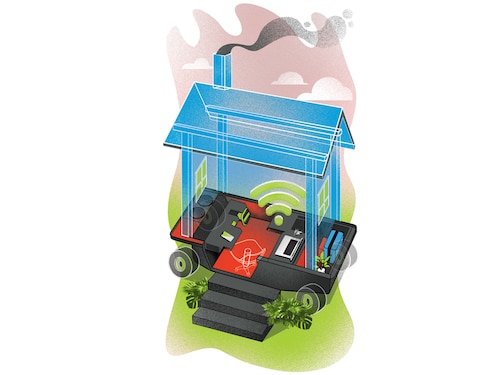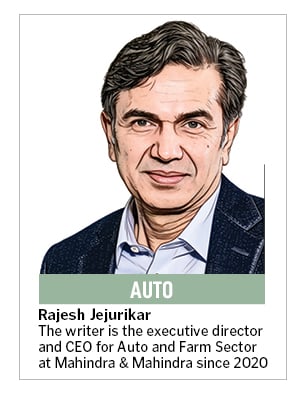Why Rajesh Jejurikar believes EVs are the path to the future
We need to start competing with the finest from around the world, and, at times, show them the way too, the executive director and CEO for Auto and Farm Sector, M&M, writes



I watched the Back to the Future movies at an impressionable age. The trilogy ends with the DeLorean being powered by Mr Fusion, a fuel that converts trash into a renewable energy source. Okay, we aren’t time-travelling yet, but yes, we are going through some exciting times for sure.
There are two ways to get things done. Following what has been done is one or starting from a blank sheet is the other. With great luck, the leapfrogging technology has given us an opportunity that borders on the divine and to start from scratch. This approach will ensure that the advantage of legacy is kept aside, and we start competing with the finest from around the world, and yes, at times, show them the way too.
Make no mistake, electric powertrains are the Fast Forward to the Future. I can sense the transformation through the seat of the pants when I drive the Mahindra XEV 9 or the BE 6. I always believed that electric adoption at a large scale will happen when the customers opt for EVs (electric vehicles) for their strengths—refinement, performance and technology.
These are the tenets that we at Mahindra will be anchoring on, as we take our steps into leadership in this arena. While doing that, we want to look good, be easy on the globe and set the templates for the same.
With two consecutive years of record-breaking passenger vehicle sales under its belt, the Indian automotive industry has cemented its position as the world’s third-largest automotive market. The country’s roads are busier than ever, not just with traffic, but with change.
The fundamentals that have propelled the automotive industry to record heights remain sound. A buoyant economy. Rising disposable incomes. A demographic dividend of young, ambitious, digitally savvy consumers. Together, these forces are combining to push India’s auto industry into uncharted, exhilarating territory.
A story of evolving aspirations Drive through any Indian city today, and you will see a shift—not just in traffic patterns, but in aspirations. The compact commuter cars of yesterday are giving way to shiny SUVs, smart EVs, and technology-laden machines that speak volumes about who their owners are.
Today’s Indian car buyers are not scared of change. They are used to adapting to new technology. They look at automobiles without the tinted glasses of status and history—they want to explore the world and look at machines as their means to achieving this. We have learnt from the success of our SUV portfolio that these customers want their vehicles to be an extension of their identity.
Global exposure, social media-fuelled comparisons, and a new sense of mobility and freedom have changed the equation. Consumers are not just buying cars. They’re curating experiences.

Gone are the days when value for money meant the lowest cost available. Today, value connects with what resonates, what excites, what elevates, and customers are all set to adopt that experience.
Our range of Mahindra SUVs has outpaced growth in the broader passenger vehicle market, despite retailing at price points that are above the industry average. This is proof that buyers have the means and the mindset to live their dreams.
From engine roar to touchscreen glow I agree that the roar of a V8, the shrill of a V12 and the staccato note of a Boxer 6 can send shivers down the spine of hardcore enthusiasts. But when these automotive icons are eclipsed on drag strips and at signal lights alike, we know it is time to sit back and enjoy change. Wait a minute, it’s only half the story now.
Today, the in-cabin experience is as important as the on-road performance. Car buyers now evaluate vehicles as much for their screen size, voice assistants, ambient lighting, connected features, and ADAS safety systems as they do their horsepower.
Your car is not just your ride—it’s your second living room, your office on the move, your entertainment pod and your command centre. What began with Bluetooth and navigation has now exploded into a full-blown digital transformation.
And it’s no coincidence that this shift has gathered speed alongside another mega trend.
EVs have done more than disrupt—they have created a level-playing field. In removing the mechanical complexities of ICE (internal combustion engine) vehicles, EVs have reset the board for everyone.
Suddenly, software is king. Legacy giants and new players now stand on equal footing. The race is not just about who builds the best engine anymore. It’s about who writes the best code, who creates the most seamless user interface, who turns a car into a connected, intelligent mobility solution. The secret is handling this change with the same amount of passion.
For Indian OEMs (original equipment manufacturers), this is a once-in-a-lifetime opening. No longer playing catch-up, we now have the chance to lead. Our products, our technology, our design language—they don’t just match global standards, they are, in many cases, streets ahead of them.
EVs are giving OEMs like us the opportunity to ‘Unlimit India’, which is what we called our Electric Origin launch event. Because this represents more than just a foray into a new segment. It marks a new beginning, a bold declaration that India will not just participate in the future of mobility—we will shape it.
EVs, the next chapter in automobile history Let’s address the sceptics.
Yes, EV adoption is still ramping up in India. Yes, infrastructure needs to improve. But look at what’s already happening.
Our eSUVs deliver a real-world in-city range of over 500 kilometres. Fast-charging technologies are shaving hours off charging times. With every passing quarter, EVs are moving from second-car experiments to one-car-for-all-purposes contenders.
EVs, as compared to other options, such as plug-in Hybrids and Hydrogen, by contrast, are simple. Clean. Scalable. And they’re getting better, cheaper, and smarter by the day.

This is what gets us excited. In the coming years, technology will evolve faster than ever. What seems futuristic today could be standard tomorrow.
And because EVs are still in their early innings, the potential for innovation is massive. Every software update, every design rethink, every consumer insight has the power to reshape the entire category.
At Mahindra, we don’t just see the EV revolution as a shift in powertrains. We see it as an opportunity to showcase what we can achieve—to unleash the full power of Indian design, engineering and ambition on a global scale.
The journey ahead will have its own twists and turns—as the Doctor and Marty experienced in the Hollywood modern classic. With the right blend of technology, aspiration, purpose and passion we believe India is not just ready for the future of mobility.
First Published: Jun 02, 2025, 11:47
Subscribe Now